List of presidents of Pakistan
The President of Pakistan is the head of state of the Islamic Republic of Pakistan. According to the Constitution of Pakistan, the President has "powers, subject to Supreme Court approval or veto, to dissolve the National Assembly, triggering new elections, and thereby dismissing the Prime Minister".[1] These powers were repeatedly modified through amendments to the constitution, which were introduced as the results of military coups and changes in government. Since the 18th Amendment to the Constitution was passed in 2010, Pakistan has been shifted back from semi-presidential to a parliamentary democratic republic. Under that system, the president has limited ruling powers, and performs ceremonial duties while the Prime Minister enjoys more powers to execute decisions.[2] The president is chosen by the Electoral College composed of the Senate, the National Assembly and the Provincial Assemblies.[3]
- The head of state of Pakistan from independence until Pakistan became a republic in 1956 was the British monarch. For the Governor-Generals who represented them from 1947 to 1956, see Governor-General of Pakistan.
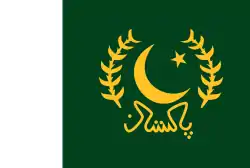
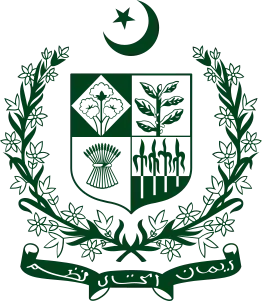 |
|---|
| This article is part of a series on the politics and government of Pakistan |
|
|
There have been thirteen presidents of Pakistan since the introduction of the post in 1956.[4] The office was established when Pakistan was declared as a republic with the adoption of the 1956 constitution, and Iskander Mirza became the first president of the country.[5][6] Apart from these twelve, two acting presidents have also been in office for short periods of time. One of them, Wasim Sajjad, served as acting president on two non-consecutive occasions during 1993 and 1997–98.[7] The president may remain in office for a tenure of five years. In the case where a president's term of office is terminated early or during the absence of the president, the Chairman of the Senate assumes office.[3]
Six presidents have been members of a political party and four of them were active party members of the Pakistan Peoples Party (PPP). The first president was a retired military officer, four others were incumbent military officers of which three gained power through successful military coups in Pakistan's history – Ayub Khan in 1958, Muhammad Zia-ul-Haq in 1977 and Pervez Musharraf in 1999.[4][8] President Zia died in office when his aircraft crashed while returning from Bahawalpur to Islamabad on 17 August 1988.[9][10] Khan, during his two terms, remained in the office for the longest period with ten years and five months approximately.[n 1][11]
The current president of Pakistan is Arif Alvi of Pakistan Tehreek e Insaf.[12]
Line of succession and removal
The Constitution discusses the possibility of an acting president. in Chapter 1: The President, Part III: The Federation of Pakistan in the Constitution of Pakistan. Certain office-holders, however, are permitted to stand as presidential candidates in case of vacancy as the constitution does not include a position of vice president:
- The Chairman of the Senate of Pakistan
- The Speaker of the National Assembly of Pakistan. in Chapter 1: The President, Part III: The Federation of Pakistan in the Constitution of Pakistan.
Territory
The dominion began as a federation of five provinces: East Bengal (later to become Bangladesh), West Punjab, Balochistan, Sindh, and the North-West Frontier Province (NWFP). Each province had its own governor, who was appointed by the Governor-General of Pakistan. In addition, over the following year the princely states of Pakistan, which covered a significant area of West Pakistan, acceded to Pakistan. They included Bahawalpur, Khairpur, Swat, Dir, Hunza, Chitral, Makran, and the Khanate of Kalat.
Radcliffe Line
The controversial Radcliffe Award, not published until 17 August 1947 specified the Radcliffe Line which demarcated the border between the parts of British India allocated to the two new independent dominions of India and Pakistan. The Radcliffe Boundary Commission sought to separate the Muslim-majority regions in the east and northwest from the areas with a Hindu majority. This entailed the partition of two British provinces which did not have a uniform majority — Bengal and Punjab. The western part of Punjab became the Pakistani province of Punjab and the eastern part became the Indian state of Punjab. Bengal was similarly divided into East Bengal (in Pakistan) and West Bengal (in India).
The Radcliffe commission had no power to divide the territory of the princely states of India.
Reign of Elizabeth II
During the coronation of Queen Elizabeth II in 1953, she was crowned as Queen of seven independent Commonwealth countries, including Pakistan, which was still a dominion at the time, whereas India was not, as the dominion of India had become a Republic of India under the new Indian constitution of 1950. As a dominion, Pakistan was represented by Governor-General of Pakistan.
Pakistan ceased being a dominion on 23 March 1956 on the adoption of a republican constitution. However, Pakistan became a republic within the Commonwealth of Nations.
The Queen visited Pakistan as Head of the Commonwealth in 1961 and 1997, accompanied by Prince Philip, Duke of Edinburgh.
Pakistan left the Commonwealth in 1972 over the issue of the former East Pakistan province becoming independent as Bangladesh. It rejoined in 1989, then was suspended from the Commonwealth twice: firstly from 18 October 1999 to 22 May 2004 and secondly from 22 November 2007 to 22 May 2008.
First Republic (1956–present)
Under the 1956 Constitution, the first constitution of the Republic of Pakistan, the President replaced the monarch as ceremonial head of state. The President was elected by the Electoral College for a five-year term. In the event of a vacancy the Speaker of the National Assembly served as Acting President.
Key
| Party name | |
|---|---|
| Republican Party | |
| Muslim League (C) | |
| Armed Forces | |
| Independent | |
| Muslim League (Q) | |
| Peoples Party | |
| Muslim League (N) | |
| Pakistan Tehreek-e-Insaf |
List of presidents of Pakistan
| No. | Portrait | Name (Birth–Death) |
Elections | Took office | Left office | Political party | Note |
|---|---|---|---|---|---|---|---|
| 1 | 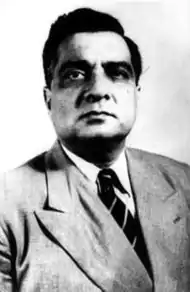 |
Iskander Mirza (1899–1969) |
1956 | 23 March 1956 | 27 October 1958 | Republican Party | |
| 2 | 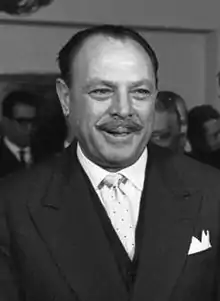 |
Ayub Khan (1907–1974) | 1958 Pakistani coup d'état | 27 October 1958 | 8 June 1962 | Military Dictator | |
| (2) | 2 January 1965 | 8 June 1962 | 29 November 1963 | Military Dictator Pakistan Muslim League (C) | |||
| — |  |
Mohammad Afzal Cheema (1913–2008) Acting |
— | 1962 | 1963 | Senior Deputy Speaker of the National Assembly 1962-1965 | |
| — |  |
Fazlul Qadir Chaudhry (1919–1973) Acting |
— | 29 November 1963 | 12 June 1965 | Pakistan Muslim League (C) | |
| (2) |  |
Ayub Khan (1907–1974) |
2 January 1965 | 12 June 1965 | 31 March 1969 | Pakistan Muslim League (C) | |
| 3 | .jpg.webp) |
Yahya Khan (1917–1980) |
—Military Dictator | 31 March 1969 | 20 December 1971 | Military Dictator | |
| 4 | .jpg.webp) |
Zulfikar Ali Bhutto (1928–1979) |
20 December 1971 | 20 December 1971 | 13 August 1973 | Pakistan Peoples Party | |
| 5 | 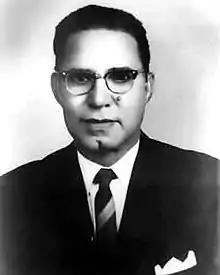 |
Fazal Ilahi Chaudhry (1904–1982) |
14 August 1973 | 14 August 1973 | 20 April 1978 | Pakistan Peoples Party | |
| — |  |
Sheikh Anwarul Haq (1917–1995) Acting |
14 August 1973 | 20 April 1978 | 7 May 1978 | Pakistan Peoples Party | |
| (5) |  |
Fazal Ilahi Chaudhry (1904–1982) |
14 August 1973 | 7 May 1978 | 16 September 1978 | Pakistan Peoples Party | |
| 6 | .jpg.webp) |
Muhammad Zia-ul-Haq (1924–1988) |
Military Dictator | 16 September 1978 | 17 August 1988 | Military Ruler | |
| 7 | .jpg.webp) |
Ghulam Ishaq Khan (1915–2006) |
13 December 1988 | 17 August 1988 | 18 July 1993 | Independent | |
| — |  |
Wasim Sajjad (1941– ) Acting |
1995 Pakistani coup d'état attempt | 18 July 1993 | 14 November 1993 | Pakistan Muslim League (N) | |
| 8 | .jpg.webp) |
Farooq Leghari (1940–2010) |
14 November 1993 | 14 November 1993 | 2 December 1997 | Pakistan Peoples Party | |
| — |  |
Wasim Sajjad (1941– ) Acting |
— | 27 December 1997 | 1 January 1998 | Pakistan Muslim League (N) | |
| 9 | 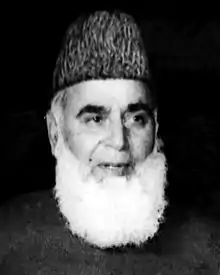 |
Muhammad Rafiq Tarar (1929–) |
31 December 1997 1999 Pakistani coup d'état | 1 January 1998 | 20 June 2001 | Pakistan Muslim League (N) | |
| 10 | 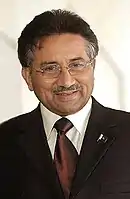 |
Pervez Musharraf (1943– ) |
Military Dictator | 20 June 2001 | 6 October 2007 | 1 January 2004[n 2] | |
| (10) | 6 October 2007 | 6 October 2007 | 18 August 2008 | Military Dictator Pakistan Muslim League (Q) | |||
| — | 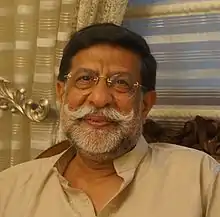 |
Muhammad Mian Soomro (1950– ) Acting |
— | 18 August 2008 | 9 September 2008 | Pakistan Muslim League (N) | |
| 11 |  |
Asif Ali Zardari (1955– ) |
6 September 2008 | 9 September 2008 | 9 September 2013 | Pakistan Peoples Party | |
| 12 | 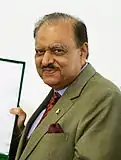 |
Mamnoon Hussain (1941– ) |
30 July 2013 | 9 September 2013 | 9 September 2018 | Pakistan Muslim League (N) | |
| 13 | 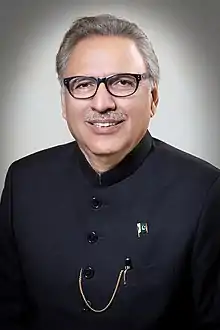 |
Arif Alvi (1949– ) |
4 September 2018 | 9 September 2018 | Incumbent (Term ends on 9 September 2023) |
Pakistan Tehreek-e-Insaf |
Living former presidents of Pakistan
- Living former presidents

.jpg.webp)

.jpg.webp)
See also
- Governor-General of Pakistan
- List international trips made by the President of Pakistan
- List of Prime Ministers of Pakistan
- History of Pakistan
- Politics of Pakistan
- Political history of Pakistan
- Constitution of Pakistan of 1956
- Constitution of Pakistan of 1962
- Constitutional economics
- Constitutionalism
- List of heads of state of Pakistan
Notes
- As of July 2017
- Musharraf took vote of confidence from the electoral college of Pakistan and elected himself as a President of Pakistan.[13]
References
- "The President's Role". Presidency of the Islamic Republic of Pakistan. Archived from the original on 7 November 2012. Retrieved 16 January 2013.
- "Pakistan parliament agrees to curb presidential powers". BBC News. 8 April 2010. Retrieved 4 July 2012.
- "The constitution of the islamic republic of pakistan" (pdf). National Assembly of Pakistan. Retrieved 4 July 2012.
- "Previous Presidents". Presidency of the Islamic Republic of Pakistan. 25 April 2011. Archived from the original on 7 November 2012. Retrieved 16 January 2013.
- Monitoring Desk (14 November 2012). "Former President Iskander Mirza remembered". The Frontier Post. Retrieved 16 January 2013.
- "Iskander Mirza". PakistanHerald.com. Retrieved 16 January 2013.
- "Wasim Sajjad". DailyPakistan.com. Archived from the original on 14 May 2013. Retrieved 16 January 2013.
- "World: South Asia – Pakistan's army and its history of politics". BBC News. 12 October 1999. Retrieved 16 January 2013.
- Fathers, Michael (18 August 1998). "Obituary: President Mohammad Zia ul — Haq". The Independent. Retrieved 16 January 2013.
- Ali, Hasan (19 August 2008). "4 military dictators among 14 heads of state under Officers' Club of Revolutionary Armed Forces". Daily Times. Archived from the original on 16 April 2013. Retrieved 16 January 2013.
- Aziz, Sartaj (2009). Between Dreams and Realities: Some Milestones in Pakistan’s History. Karachi, Pakistan: Oxford University Press. p. 408. ISBN 978-0-19-547718-4. Archived from the original on 2013-09-19.
- "Arif Alvi sworn in as 13th President of Pakistan". DAWN.COM. 9 September 2018. Retrieved 12 September 2018.
- Waldman, Amy (2 January 2004). "Pakistan gives Musharraf confidence vote as president". The New York Times. Retrieved 20 January 2013.
External links
"Presidents". WorldStatesman.org.
